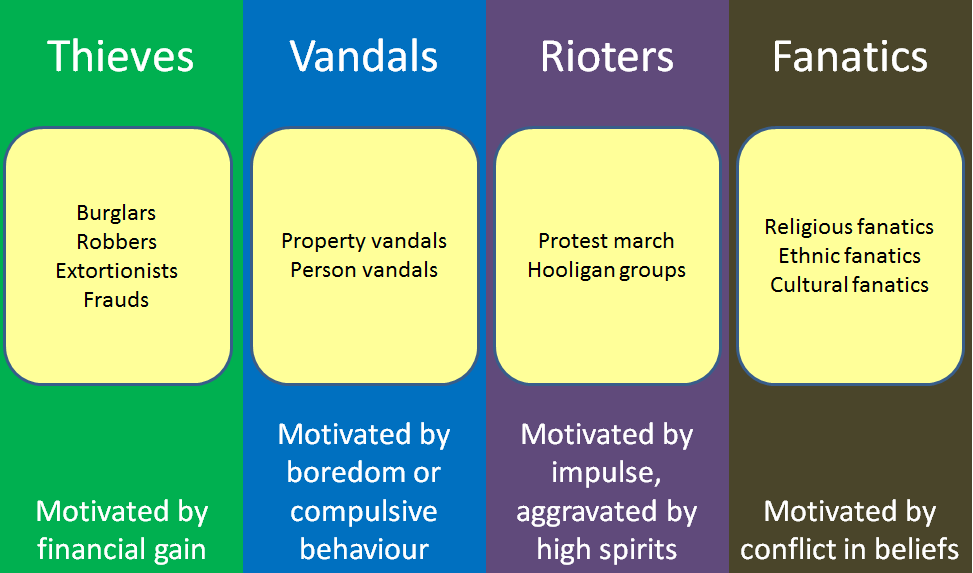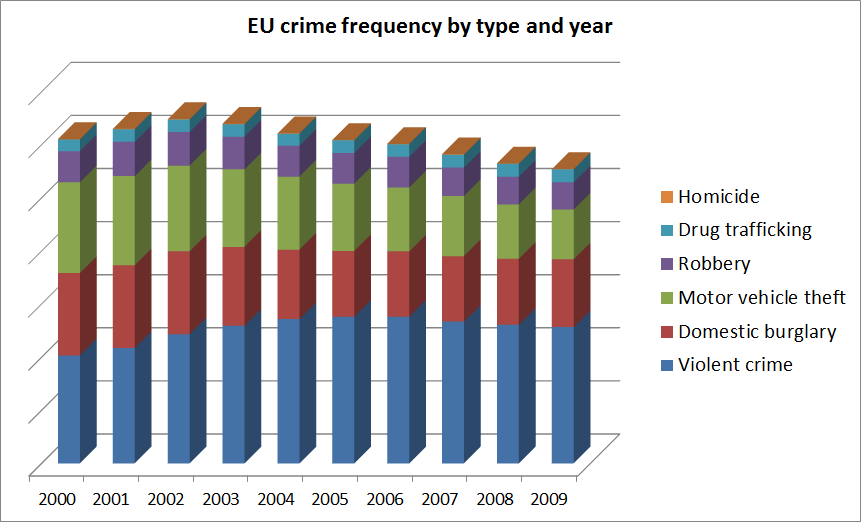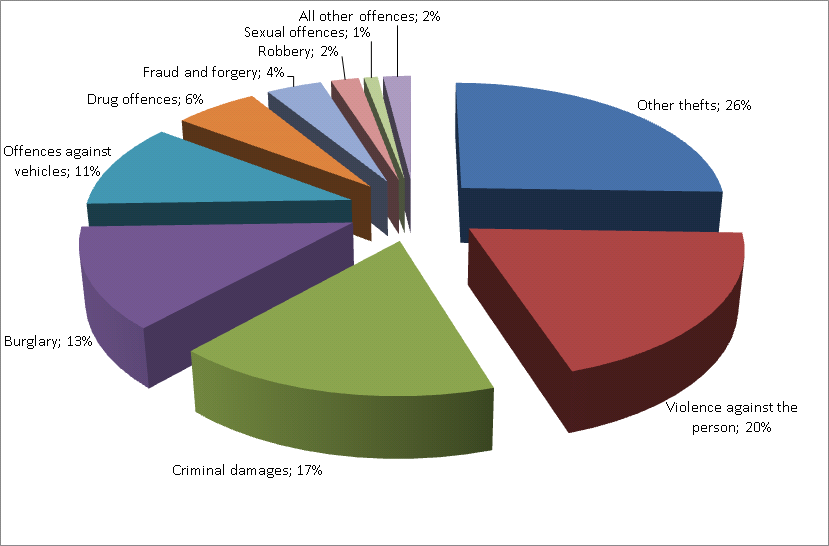Difference between revisions of "Crime"
| (46 intermediate revisions by 3 users not shown) | |||
| Line 1: | Line 1: | ||
[[Category:Safety |
[[Category:Safety]] |
||
[[Category:Threat]] |
|||
={{PAGENAME}}= |
|||
[[File:ae.png|25px|right|This is a page providing background in a specific field of expertise]]'''Crime''' is |
[[File:ae.png|25px|right|This is a page providing background in a specific field of expertise]]'''Crime''' is an act of breaching one or several rules of laws (formal conventions) by which not only an individual, but also the community or the state is harmed. Such acts are forbidden and and punishable by law because some governing authority (via mechanisms such as legal systems) can ultimately prescribe a conviction.<ref>from: [[wikipedia:crime|wikipedia]]</ref> |
||
== |
==Conditions for crime taking place== |
||
In brief, a criminal event happens when a predisposed, motivated and resourceful offender encounters, or engineers, a conducive crime situation. The situation in turn comprises a suitable target in a favourable environment, in the absence of |
In brief, a criminal event happens when a predisposed, motivated and resourceful offender encounters, or engineers, a conducive crime situation. The situation in turn comprises a suitable target in a favourable environment, in the absence of factors (e.g. people) preventing the crime and the presence of factors supportive of it. This has been called the Conjunction of Criminal Opportunity<ref>[[http://www.google.nl/url?sa=t&rct=j&q=safer%20places%20secured%20by%20design&source=web&cd=1&cad=rja&ved=0CCQQFjAA&url=http%3A%2F%2Fwww.securedbydesign.com%2Fpdfs%2Fsafer_places.pdf&ei=wbKjUMS6HMiY0QXb-4CoBw&usg=AFQjCNEzsAinC6nIIKZGLPRNX1ARTSqN4A Secured by design - Safer Places]]</ref><ref>Ekblom, ''The conjunction of criminal opportunity'', http://webarchive.nationalarchives.gov.uk/20100413151441/http://www.crimereduction.gov.uk/learningzone/ccofull.pdf</ref> |
||
== |
==Crime categorisation== |
||
Crime can take many forms. In order to have a clear understanding of what constitutes crime, a clear and uniform terminology, and hence a categorisation would be required. At the moment, there does not exist an uniform and widely accepted categorisation of crimes. Rather, this categorisation is done whenever and wherever required. Some existing well-known categorisations of crime include: |
|||
A uniformly accepted categorisation of crime does not exist; rather, each country uses its own classification and often more than one. |
|||
===Legal categorisation=== |
|||
In the context of urban planning, not all types of crimes are equally relevant, due to: |
|||
The following classes of offences are used, or have been used, as legal terms of art: |
|||
* the extent to which they are infuenceable by means of urban design; |
|||
* the extent to which they form a risk, both in terms of likelihood of occurrence and impact; |
|||
*Offence against the person<ref name="ReferenceA">For example, by the [[wikipedia:Visiting Forces Act 1952|Visiting Forces Act 1952]]</ref> |
|||
==Influenceability of crime by urban design== |
|||
*Violent offence<ref name="ReferenceB">For example, by section 31(1) of the [[wikipedia:Criminal Justice Act 1991|Criminal Justice Act 1991]], and by the [[wikipedia:Criminal Justice Act 2003|Criminal Justice Act 2003]]</ref> |
|||
<to be amended> |
|||
*Sexual offence<ref name="ReferenceB" /> |
|||
*Offence against property<ref name="ReferenceA" /> |
|||
===EU categorisation=== |
|||
== Occurrence of crime== |
|||
There is no uniform European categorisation of crime. Each country uses its own system to classify and record crime at a very generic level. The collected statistics are reported to a central European database yearly , called eurostat<ref>http://epp.eurostat.ec.europa.eu/portal/page/portal/crime/data/database</ref>. The crimes in this database encompass the following six categories: |
|||
Not every type of crime occurs equally frequent. The crime statistics of England and Wales of the year 2010-2011<ref>http://www.homeoffice.gov.uk/publications/science-research-statistics/research-statistics/crime-research/hosb1011/hosb1011?view=Binary</ref> present the following ratios in recorded crime types: |
|||
*Homicide<ref>Definition: This is defined as intentional killing of a person, including murder, manslaughter, euthanasia and infanticide. Causing death by dangerous driving is excluded, as are abortion and help with suicide. Attempted (uncompleted) homicide is also excluded. The counting unit for homicide is normally the victim (rather than the case).</ref>, |
|||
[[File:crime statistics England and Wales 2010-2011.png|center|600px]] |
|||
*Violent crime<ref>This includes violence against the person (such as physical assault), robbery (stealing by force or by threat of force), and sexual offences (including rape and sexual assault).</ref> |
|||
*Robbery<ref>Robbery is a sub-set of violent crime. It is defined as stealing from a person with force or threat of force, including muggings (bag-snatching) and theft with violence. Pick-pocketing, extortion and blackmailing are generally not included.</ref>, |
|||
*Domestic burglary<ref>Domestic burglary is defined as gaining access to a dwelling by the use of force to steal goods.</ref> |
|||
*Vehicle theft<ref>Motor vehicles include all land vehicles with an engine that run on the road which are used to carry people (including cars, motor cycles, buses, lorries, construction and agricultural vehicles, etc.).</ref>, |
|||
*Drug trafficking<ref>Definition:This is defined as the illegal possession, cultivation, production, supplying, transportation, importing, exporting, financing etc. of drug operations which are not solely in connection with personal use.</ref> |
|||
===US categorisation=== |
|||
==Impact of crime== |
|||
The US statics, recorded by the FBI's subdivision Criminal Justice Information Services, categorises crime with a higher degree of specificity<ref>http://www.fbi.gov/about-us/cjis/ucr/crime-in-the-u.s/</ref>, but at the highest level of subdivision only |
|||
<to be amended> |
|||
*Violent crime and |
|||
==Crimes relevant for the urban planner== |
|||
*Property crime |
|||
The types of crime that are deemed relevant enough for the urban planning process to be explicitly elaborated in this Securipedia, are called Security Issues. These issues are: |
|||
are discriminated. |
|||
* [[Security issue: Burglary|Burglary]] |
|||
* [[Security issue: Ram raid|Ram-raiding]] |
|||
* [[Security issue: Pickpocketing|Pickpocketing]] |
|||
* [[Security issue: Robbery|Robbery]] |
|||
* [[Security issue: Vehicle theft|Vehicle theft]] |
|||
* [[Security issue: Assault|Physical assault]] |
|||
* [[Security issue: Sexual assault|Sexual assault]] |
|||
* [[Security issue: Vandalism|Vandalism]] |
|||
* [[Security issue: Destruction by riots|Destruction by riots]] |
|||
* [[Security issue: Destruction by fanatics|Destruction of property by fanatics]] (terrorists) |
|||
* [[Security issue: Grafitti|Graffiti]] |
|||
* [[Security issue: Mass killing|Mass killing]] (by fanatics) |
|||
* [[Security issue: Raid|Raid]] (commercial theft with use of violence) |
|||
* [[Security issue: Antisocial behaviour|Antisocial Behaviour]] |
|||
===UK categorisation=== |
|||
{{references}} |
|||
The UK crime statistics, recorded in the annual report 'Crime in England and Wales'<ref>https://www.gov.uk/government/uploads/system/uploads/attachment_data/file/116435/hosb0812.pdf</ref>, uses yet another categorisation of crimes, the highest subdivision of which is: |
|||
*Property crime |
|||
=MAP= |
|||
*Drug offences |
|||
<websiteFrame> |
|||
*Other miscellaneous offences |
|||
website=http://securipedia.eu/cool/index.php?wiki=securipedia.eu&concept=Crime |
|||
height=1023 |
|||
===Categorisation by motive=== |
|||
width=100% |
|||
A classification that is developed<ref>Developed in the [http://www.securehaven.nl/ Secure haven project (in Dutch)] and adapted for use in the [[Concept level tools#Risk Assessment tool (SecuRbAn)|Securban]] tool component and this wiki.</ref> for use in the urban environment that the types of crime most relevant to urban design, is based on the motivation of perpetrators: |
|||
border=0 |
|||
scroll=auto |
|||
<imagemap> |
|||
align=middle |
|||
Image:Clip image004.png|thumb|right|400px|'''Classification of crimetypes''' |
|||
</websiteFrame> |
|||
<headertabs/> |
|||
rect 41 30 202 81 [[Thief|Thieves]] |
|||
rect 269 30 462 84 [[Vandal|Vandals]] |
|||
rect 509 27 704 84 [[Rioter|Rioters]] |
|||
rect 754 28 947 84 [[Fanatic|Fanatics]] |
|||
rect 40 197 196 226 [[Thief#Burglars|Burglars]] |
|||
rect 40 225 195 253 [[Thief#Robbers|Robbers]] |
|||
rect 41 253 193 285 [[Thief#Extortionists|Extortionists]] |
|||
rect 44 286 193 312 [[Thief#Frauds|Frauds]] |
|||
rect 277 227 454 255 [[Vandal#Property vandals|Property vandals]] |
|||
rect 278 255 454 283 [[Vandal#Person vandals|Person vandals]] |
|||
rect 521 227 692 254 [[Rioter#Protester|Protester]] |
|||
rect 521 254 693 282 [[Rioter#Hooligan|Hooligans]] |
|||
rect 758 213 945 241 [[Fanatic#Religious fanatic|Religious fanatic]] |
|||
rect 764 240 946 268 [[Fanatic#Ethnic fanatics|Ethnic fanatics]] |
|||
rect 763 267 946 298 [[Fanatic#Cultural fanatics|Cultural fanatics]] |
|||
desc bottom-left |
|||
</imagemap> |
|||
The first category of criminals ('''[[Thief|thieves]]''') is motivated by financial gain. They can be subdivided into: |
|||
*[[Thief#Burglars|Burglars]], who gain wealth by illicitly entering buildings, |
|||
*[[Thief#Robbers|Robbers]], who gain wealth by force of threat. |
|||
*[[Thief#Extortionists|Extortionists]], who gain wealth by use of coercion and |
|||
*[[Thief#Frauds|Frauds]], who gain wealth by intentional deception |
|||
The second category of criminal ('''[[vandal|vandals]]''') is motivated by amusement (such as bored youth bothering passers-by) or by compulsive behaviour (such as pyromaniacs). They can be sub divided into: |
|||
*[[vandal#property vandal|Property vandals]], who seek damage or destruction of property, and |
|||
*[[vandal#person vandal|Person vandals]], who assaults other people physically or mentally. |
|||
The third category ('''[[rioter|rioters]]''') is motivated by impulse, often under group pressure, often in a situation with a high level of excitement or arousal. Two subtypes of rioters are: |
|||
*[[rioter#protester|Protesters]] and |
|||
*[[rioter#hooligan|Hooligans]]. |
|||
The fourth and last category is motivated by conflict in beliefs ('''[[fanatic|fanatics]]''') and tries to impose rules or beliefs upon others by use of coercion. The level of coercion can vary a great deal, ranging from mental abuse to mass killing. '''DIT IS EEN VORM VAN TERRORISME DUS HIER NAAR LINKEN EN DIT UITLEGGEN> Mogelijk is er een 5de categorie terroristen, naast fanatics. Hoe gaan we hier mee om?''' Subtypes of fanatics are: |
|||
*[[fanatic#religious fanatics|Religious fanatics]], who try to impose religious beliefs or religious rules |
|||
*[[fanatic#ethnic fanatics|Ethnic fanatics]], who coerce specific ethnic groups and |
|||
*[[fanatic#cultural fanatics|Cultural fanatics]], who try to impose cultural beliefs (for example about animal welfare in the fur industry, globalism or conservationism) upon others. |
|||
[[File:Security issues.PNG|thumb|right|400px|'''Taxonomy of crime types used in the Securipedia; 'security issues''''|link=Security issues]]None of these categorisations know an EU wide base of use (at least not among parties the urban planner would be involved with). This is why two categorisation of crime were developed: The categorisation for use at the conceptual level, and a categorisation for use at the plan level. The categorisation of crime at the conceptual level is developed from the above mentioned categorisation by motive. The constituent crimes are called [[Security issues]] and are categorized to the prime concern to the urban planners in a conceptual stage. The [[categorisation of crime at the plan level]] conforms with the arrangement of a dataset of recorded crimes of the police force area of West Yorkshire Police, which is used as a basis for the calculation of empirical risk. |
|||
==Frequency of crime== |
|||
[[File:crimestatseu.png|thumb|right|400px|'''Crimetype statistics in the EU''']] |
|||
[[File:crime statistics England and Wales 2010-2011.png|thumb|right|400px|Crimetype statistics in England and Wales 2010-2011]]An indication of the relative size of crime types recorded in the eurostat database and their development through the years is given in the figure to the right.<ref>Derived from [http://ec.europa.eu/eurostat/product?code=crim_gen&language=en&mode=view Eurostat crime statistics database] "Crim_gen"</ref>. In this figure, we can discern the large differences in rate of occurance between faily commonplace crimes, like vehicle theft or violence and more extreme crimes, like homocide. |
|||
As an illustration of the variability in the way and level of detail crimes are recorded in the various member states, the crime statistics of England and Wales of the year 2010-2011<ref>http://www.homeoffice.gov.uk/publications/science-research-statistics/research-statistics/crime-research/hosb1011/hosb1011?view=Binary</ref> are presented in the figure to the right. |
|||
{{references}} |
|||
Latest revision as of 08:52, 3 September 2020
Crime is an act of breaching one or several rules of laws (formal conventions) by which not only an individual, but also the community or the state is harmed. Such acts are forbidden and and punishable by law because some governing authority (via mechanisms such as legal systems) can ultimately prescribe a conviction.[1]
Contents
Conditions for crime taking place
In brief, a criminal event happens when a predisposed, motivated and resourceful offender encounters, or engineers, a conducive crime situation. The situation in turn comprises a suitable target in a favourable environment, in the absence of factors (e.g. people) preventing the crime and the presence of factors supportive of it. This has been called the Conjunction of Criminal Opportunity[2][3]
Crime categorisation
Crime can take many forms. In order to have a clear understanding of what constitutes crime, a clear and uniform terminology, and hence a categorisation would be required. At the moment, there does not exist an uniform and widely accepted categorisation of crimes. Rather, this categorisation is done whenever and wherever required. Some existing well-known categorisations of crime include:
Legal categorisation
The following classes of offences are used, or have been used, as legal terms of art:
EU categorisation
There is no uniform European categorisation of crime. Each country uses its own system to classify and record crime at a very generic level. The collected statistics are reported to a central European database yearly , called eurostat[6]. The crimes in this database encompass the following six categories:
- Homicide[7],
- Violent crime[8]
- Robbery[9],
- Domestic burglary[10]
- Vehicle theft[11],
- Drug trafficking[12]
US categorisation
The US statics, recorded by the FBI's subdivision Criminal Justice Information Services, categorises crime with a higher degree of specificity[13], but at the highest level of subdivision only
- Violent crime and
- Property crime
are discriminated.
UK categorisation
The UK crime statistics, recorded in the annual report 'Crime in England and Wales'[14], uses yet another categorisation of crimes, the highest subdivision of which is:
- Property crime
- Drug offences
- Other miscellaneous offences
Categorisation by motive
A classification that is developed[15] for use in the urban environment that the types of crime most relevant to urban design, is based on the motivation of perpetrators:
The first category of criminals (thieves) is motivated by financial gain. They can be subdivided into:
- Burglars, who gain wealth by illicitly entering buildings,
- Robbers, who gain wealth by force of threat.
- Extortionists, who gain wealth by use of coercion and
- Frauds, who gain wealth by intentional deception
The second category of criminal (vandals) is motivated by amusement (such as bored youth bothering passers-by) or by compulsive behaviour (such as pyromaniacs). They can be sub divided into:
- Property vandals, who seek damage or destruction of property, and
- Person vandals, who assaults other people physically or mentally.
The third category (rioters) is motivated by impulse, often under group pressure, often in a situation with a high level of excitement or arousal. Two subtypes of rioters are:
- Protesters and
- Hooligans.
The fourth and last category is motivated by conflict in beliefs (fanatics) and tries to impose rules or beliefs upon others by use of coercion. The level of coercion can vary a great deal, ranging from mental abuse to mass killing. DIT IS EEN VORM VAN TERRORISME DUS HIER NAAR LINKEN EN DIT UITLEGGEN> Mogelijk is er een 5de categorie terroristen, naast fanatics. Hoe gaan we hier mee om? Subtypes of fanatics are:
- Religious fanatics, who try to impose religious beliefs or religious rules
- Ethnic fanatics, who coerce specific ethnic groups and
- Cultural fanatics, who try to impose cultural beliefs (for example about animal welfare in the fur industry, globalism or conservationism) upon others.
None of these categorisations know an EU wide base of use (at least not among parties the urban planner would be involved with). This is why two categorisation of crime were developed: The categorisation for use at the conceptual level, and a categorisation for use at the plan level. The categorisation of crime at the conceptual level is developed from the above mentioned categorisation by motive. The constituent crimes are called Security issues and are categorized to the prime concern to the urban planners in a conceptual stage. The categorisation of crime at the plan level conforms with the arrangement of a dataset of recorded crimes of the police force area of West Yorkshire Police, which is used as a basis for the calculation of empirical risk.
Frequency of crime
An indication of the relative size of crime types recorded in the eurostat database and their development through the years is given in the figure to the right.[16]. In this figure, we can discern the large differences in rate of occurance between faily commonplace crimes, like vehicle theft or violence and more extreme crimes, like homocide.
As an illustration of the variability in the way and level of detail crimes are recorded in the various member states, the crime statistics of England and Wales of the year 2010-2011[17] are presented in the figure to the right.
Footnotes and references
- ↑ from: wikipedia
- ↑ [Secured by design - Safer Places]
- ↑ Ekblom, The conjunction of criminal opportunity, http://webarchive.nationalarchives.gov.uk/20100413151441/http://www.crimereduction.gov.uk/learningzone/ccofull.pdf
- ↑ 4.0 4.1 For example, by the Visiting Forces Act 1952
- ↑ 5.0 5.1 For example, by section 31(1) of the Criminal Justice Act 1991, and by the Criminal Justice Act 2003
- ↑ http://epp.eurostat.ec.europa.eu/portal/page/portal/crime/data/database
- ↑ Definition: This is defined as intentional killing of a person, including murder, manslaughter, euthanasia and infanticide. Causing death by dangerous driving is excluded, as are abortion and help with suicide. Attempted (uncompleted) homicide is also excluded. The counting unit for homicide is normally the victim (rather than the case).
- ↑ This includes violence against the person (such as physical assault), robbery (stealing by force or by threat of force), and sexual offences (including rape and sexual assault).
- ↑ Robbery is a sub-set of violent crime. It is defined as stealing from a person with force or threat of force, including muggings (bag-snatching) and theft with violence. Pick-pocketing, extortion and blackmailing are generally not included.
- ↑ Domestic burglary is defined as gaining access to a dwelling by the use of force to steal goods.
- ↑ Motor vehicles include all land vehicles with an engine that run on the road which are used to carry people (including cars, motor cycles, buses, lorries, construction and agricultural vehicles, etc.).
- ↑ Definition:This is defined as the illegal possession, cultivation, production, supplying, transportation, importing, exporting, financing etc. of drug operations which are not solely in connection with personal use.
- ↑ http://www.fbi.gov/about-us/cjis/ucr/crime-in-the-u.s/
- ↑ https://www.gov.uk/government/uploads/system/uploads/attachment_data/file/116435/hosb0812.pdf
- ↑ Developed in the Secure haven project (in Dutch) and adapted for use in the Securban tool component and this wiki.
- ↑ Derived from Eurostat crime statistics database "Crim_gen"
- ↑ http://www.homeoffice.gov.uk/publications/science-research-statistics/research-statistics/crime-research/hosb1011/hosb1011?view=Binary



